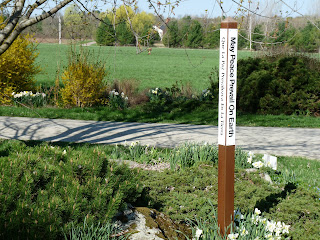The Vermont Zen Center in located in Shelburne, a small,
artistically-inclined community outside Burlington, which itself is a pretty
city on Lake Champlain. One notices the Peace Pole at the foot of the Center’s drive
before one sees the official sign set in a small flower bed. The sign has the
calligraphy figure with the three vertical strokes associated with the Kapleau
lineage and the simple declaration: Zen Center.
Proceeding up the
driveway, the next thing one notices is the landscaping. The grounds are
impressive and lovingly cared for. The Magnolia trees are in full bloom, their
bases littered with large white petals. The rhododendron is in flower, along
with many colorful bedding plants. The teacher, Sunyana Graef (her students
call her “Roshi”) informs me that when they bought the house, it was in the
middle of an alfalfa field and there was only a single tree—a pine which now
towers over the property. A spruce the sangha (community) planted, however, has
almost reached its height. The sangha is celebrating its’ 25th anniversary this
year. The cedars and other trees, plants, bushes, and flower beds have all been
added in that period.
Inside the
building, one is struck by the craftsmanship apparent everywhere. The original
house has had several extensions and is now able to house sixty people for
sesshin—comfortably. I admire the care taken with both the woodwork and the
lighting around the various shrines. Polished hardwood floors run throughout
the building. The first room one enters is a living room, with stuffed
furniture and a big fireplace. Sunyana explains that she wanted the members to
form a community, to get to know one another. If they went straight into the
Zendo or the Buddha Hall, they might never get to know one another. So they
take a moment to sit and chat before proceeding into the formal areas of the
center. It’s the type of touch I will learn to expect from her.
“How did you
become a teacher?” I ask.
“My teacher
[Philip Kapleau] told me it was time.”
“And then you came
to Vermont. Was that because he asked you to come here?”
“No. My husband
and I chose to come here.”
“Was there a
community here?”
“No. Not really.”
“But you’d lived
here before?”
“No.”
“So, why . . . ?”
She grins
bashfully and looks away (she has several shy mannerisms and asks me not to
take her photograph). Then she spreads her hand and shoulders in a gesture
which recalls her Jewish heritage and says, “I like cows.”
She remembered driving
through the state as a child. It struck her as bucolic and beautiful. It is.
This is the first time Joan and I have been to the state, and we are both struck
by how attractive it is. The Zen Center fits its surroundings. The building
and grounds are elegant.
It is a space one
could easily come to love.
There is a Jizo
figure under the magnolias out front, and a small Jizo grove in back. But the dominant
devotional figure in the building is Kannon—the Bodhisattva of Compassion.
There are several statues of her, including one that greets people who come in
the front door. Sunyana trained at Rochester, where the style of teaching has frequently
been described as “boot camp Zen” or “Samurai Zen.” The emphasis in Rochester, she tells me, was
on the attainment of wisdom (awakening) but maybe not as much on the attainment
of compassion as it should have been.
Sunyana does not
use the kyosaku. “Roshi [Kapleau] relished telling how when he was training at
Hossinji with Harada Roshi he would stay
up all night being beaten on the shoulders by a monitor, but he didn’t make his
breakthrough there.” It wasn’t until he came under the milder training of
Yasutani Roshi that he had his awakening experience, and yet—ironically—when he
started teaching in Rochester, he returned to the harsher training methods used
by Harada. Well, it was the ‘60s, and most of his students were hippies. He may
well have thought they needed the discipline.
There are several
kinds of retreats offered at the Vermont Center, in addition to the standard
seven day sesshin focused on seated meditation. There are “work” sesshin, in
which people spend more time working on the grounds. And there are “Metta”
Retreats—Loving Kindness retreats. These are now led by one of Sunyana’s
disciples, Dharman—a former university professor who shame-facedly admits he
taught a course on Buddhism while in the department of philosophy before he had
begun practice.
I ask him what
makes Sunyana (Roshi) a good teacher. The first thing he mentions is her integrity.
And then he stresses her compassion. “I’m so glad I found a teacher who was a
woman,” he tells me.
She also happens to be a professional baker.
I get the feeling
that Sunyana is a teacher one could easily come to love.
Cypress Trees in the Garden:
Cypress Trees in the Garden:
Graef, Sunyana – 204, 329, 337-51,
361, 374, 388-89, 468


No comments:
Post a Comment